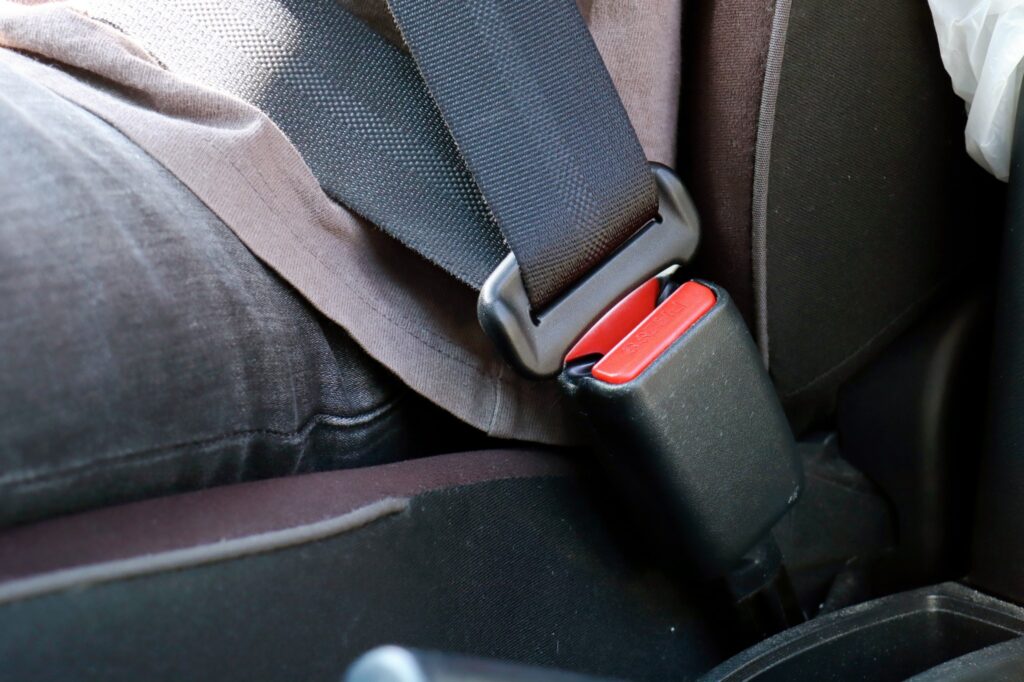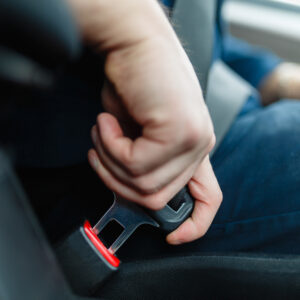Any kind of issue concerning your seatbelt should not be taken lightly. Your seatbelt is one of the many things in your car that’s designed to keep you safe, much like your brakes and air bags.
So when you notice even a small tear or signs of wear on your seatbelt and its related parts, you might want to consider fixing it or getting a new one.
What Are Seat Belts Made Of?
During the early stages of its development, the seatbelt was made from nylon. Over the years, however, polyester proved to be a viable and more effective replacement for nylon.

Polyester doesn’t stretch as much as nylon and is more durable. Polyester is also easier to maintain and is better at retaining its color.
Seat belt material is 100% woven polyester. The webbing pattern of the seat belt makes it resistant to extreme tensile strength.
What Does It Mean When You Have a Frayed Seat Belt?
When a seat belt is frayed, it means the threads have separated slightly, creating loose ends.
Other than regular wear and tear, seat belt fraying happens whenever the belt gets caught on sharp objects and clothing accessories like zippers and buttons. The seat belt can also get frayed when it gets chewed on by your furry friends.
A frayed seat belt might seem like a small issue, mainly because the belt is still pretty much intact. However, over some time, the fraying can cause the belt to get stuck in the mechanism and create a loose fitting over the passenger or driver.
Keep in mind that a properly functioning seat belt should be fastened on your lap and reach across your chest and shoulders.
If the seat belt were to have any slack, the driver and passenger/s could suffer severe injuries.
How to Stop a Seat Belt from Fraying and Other Maintenance Tips to Remember
Fraying is an unavoidable issue that can affect the quality of your seat belt. There are, however, a few things you can do to delay this process and make the most out of your seat belt.
Strap On Some Seat Belt Protectors
A seat belt protector or cover is a soft material that wraps around a portion of the seat belt, creating a soft cushion that helps the driver or passenger feel more comfortable while wearing it.
Keep in mind, however, that the protector shouldn’t be used to cover up seat belt damage. Always consider replacing frayed seat belts with new ones.
Most seat belt covers have velcro straps for easy attachment and adjustment. Aside from enhancing comfort, these covers can also protect the belts from getting caught on objects that can damage their fabric.
Always Keep the Seat Belt Mechanism Clean
When it comes to seat belts, fraying isn’t the only thing you should keep an eye on. For your seat belts to function properly, it’s also important to keep their mechanisms clean to prevent the buckle from getting stuck.
The buckles on seat belts can easily accumulate grime and debris, which can affect the seat belts’ effectiveness.
Make sure to clean the buckles with a vacuum cleaner. Avoid using harsh detergents and cleaning solutions to prevent damaging or corroding the mechanism.
Can You Repair a Frayed Seat Belt?
Ideally, frayed seat belts should always be replaced instead of repaired. Frayed edges can compromise the structural integrity of seat belts, and trimming them off with scissors or sewing a new fabric can only make matters worse.
In some countries, driving with a frayed seat belt imposes the same risks of driving without a seat belt, which is considered a punishable offense.
Keep in mind that your safety should always be your priority whenever you’re in a vehicle. Never cut back on quality when it comes to seat belts and other safety features, even if it means shelling out a few bucks.
When to Replace Your Seat Belt
Seat belts are meant to last a long time, but there might come a time when you’ll need to replace them. Like all car parts, they’re not going to last forever.
Ideally, you’ll need to replace your seat belts once they’re worn out or if your vehicle was involved in a major collision.
When the Seat Belt is Worn or Damaged
Aside from all the tugging and pulling, seat belts can wear out after being exposed to dust and other particles. These contaminants can easily get into the locking mechanisms and create problems.
If you often park under the sun with minimal shade, extreme heat can cause the seat belt’s plastic parts to deteriorate faster than normal.
It’s also important to keep an eye out for bleached or faded webbing. This means that the seat belt is getting damaged from UV rays.
After a Crash
According to the protocols set by the National Highway Traffic Safety Administration (NHTSA), safety items like seat belts and air bags are for single use only in the event of a crash.
If your vehicle is involved in a collision, the seat belt’s pretensioner will activate the retractor, locking the belt in place.
The pretensioner has a piston that spools the webbing of your seat belt to remove all slack. In the event of a collision, the seat belt’s stalk cover will deform, the buckle will sag, and the retractor will be rendered inoperable.
Key Takeaways
Seat belts are 100% woven polyester, making them extremely durable. While this might be the case, keep in mind that they’re still susceptible to damage and wear.
Fraying is one of the most common issues you might encounter with your seat belt. This issue is characterized by separated threads on the edges, which can affect the seat belt’s structural integrity.
Frayed seat belts are not meant to be repaired with additional fabric. Instead, they should always be replaced with new ones.
Aside from fraying, seat belts should also be replaced when the locking mechanisms begin to fail and if they’re damaged from the crash. In the event of a collision, seat belts are meant to be single-use safety items.
Any information provided on this Website is for informational purposes only and is not intended to replace consultation with a professional mechanic. The accuracy and timeliness of the information may change from the time of publication.






































